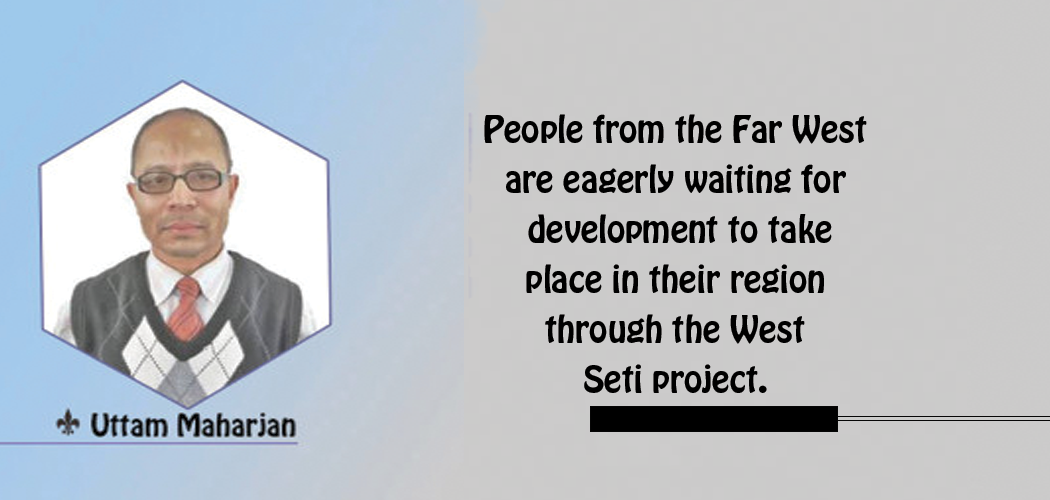- Monday, 15 December 2025
Complete West Seti Project
Uttam Maharjan
Project delay is the order of the day in Nepal. One of the burning examples is the West Seti Hydroelectric Project. The project site is located in the West Seti river in the Far West of the country. The project covers six districts: Baitadi, Bajhang, Doti, Dadeldhura, Kailali and Kanchanpur. The reservoir site lies in Baitadi and Bajura, whereas the transmission line corridor lies in Doti, Dadeldhura, Kailali and Kanchanpur. All the other sites lie in Doti and Dadeldhura. The elevation of the project site ranges from 550 to 920 metres. The proposed dam lies 82 kilometres upstream of the confluence of the Seti and Karnali rivers.
The West Seti project is a reservoir-type hydel project with a capacity for generating 750 megawatts. In 1981 AD, a 37 MW run-of-the-river hydel scheme was proposed based on preliminary studies conducted in 1980-81. In 1987, a French company, Sogreah, prepared the pre-feasibility study. In the study, a 37 MW run-of-the-river hydel project without a dam was proposed. The project was later revised to a 380 MW reservoir-type hydel project, reasoning that power could be optimally generated without causing impacts on the environment.
Export-oriented project
In 1994, an Australian company, Snow Mountain Engineering Corporation (SMEC), was permitted to survey the site for the West Seti project. The company was later given a construction licence in 1997. The project was originally designed as an export-oriented project with the intention of selling surplus electricity to India. The cost was estimated at Rs. 120 billion. But the company did not press ahead with work on the project. The government revoked its licence in 2011.
When SMEC was occupying the project, China National Machinery and Equipment Import and Export Corporation (CMEC) decided to invest Rs. 15 billion in the West Seti project. An agreement was signed to this effect during former prime minister Madhav Kumar Nepal’s visit to China in 2009. CMEC later opted out of the project, citing lack of an investment-friendly environment in the country. The Asian Development Bank, a shareholder in the Chinese company, also did not evince interest in the project, citing lack of public acceptance of the project and the absence of good governance.
The project was then assigned to China Three Gorges International Corporation, China’s biggest hydropower developer and operator of the world’s largest hydropower plant at the Three Gorges dam at Yangtze, in 2012. In 2017, Nepal Electricity Authority signed a final agreement with the company. This generated a flicker of hope that the project would take off. However, in 2018, the company hinted at opting out of the project, citing huge resettlement costs.
As the project was on the backburner for a long period of time, former Finance Minister Yuvaraj Khatiwada announced in the 2020-21 annual budget that the West Seti project would be completed through internal resources by cancelling the USD 1.6 billion plan of the Chinese company. In 2019, Investment Board Nepal revised the cost of the project and presented it at the Nepal Investment Summit 2019. The revised cost was USD 2.02 billion. But unfortunately, no investors showed interest in the project. In fact, although the project was one of the biggest among the eight hydropower projects presented at the summit, the investment sources and modality of the project could not be developed and the investors could not be convinced to invest in the project.
Although there is no official load- shedding, industrial houses have been facing undeclared load shedding for quite a long time. During the winter, the supply of electricity is not enough; some electricity has to be imported from India. This time, the cost of electricity in India is unexpectedly high owing to the Ukraine war. As such, the country did not import electricity from India. To solve electricity problems during the winter and to export surplus electricity to India and other neighbouring countries, it is important to complete the project. In September 2021, a team of experts, including the chief of Investment Board Nepal, visited the proposed dam site of the West Seti project in Doti. The team assured the locals that the project would take off soon.
Domestic funding
Although the government was mulling over constructing the West Seti project on its own, the report prepared by the team of National Planning Commission, including the vice-chairman of the commission, has concluded that the country cannot construct the project on its own. As such, the government is seeking a foreign company for the project. Prime Minister Deuba has recently revealed that the West Seti project may be handed over to an Indian company. This is because India has said that it will not buy electricity generated by hydropower projects developed by foreign companies or built by foreign contractors.
The Far West region of the country is rich in natural resources. But it has remained undeveloped for decades. It has remained at the bottom of the human development index. People from the Far West are eagerly waiting for development to take place in their region through the West Seti project. The project should be completed at the earliest. After all, the project lying fallow for decades is not a small deal.
(Maharjan has been regularly writing on contemporary issues for this daily since 2000. uttam.maharjan1964@gmail.com)
















